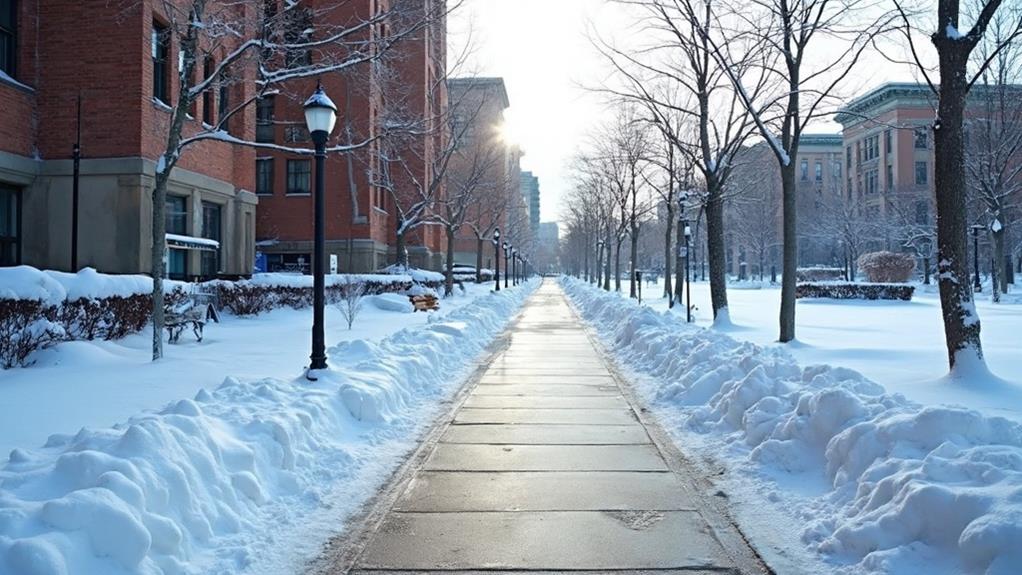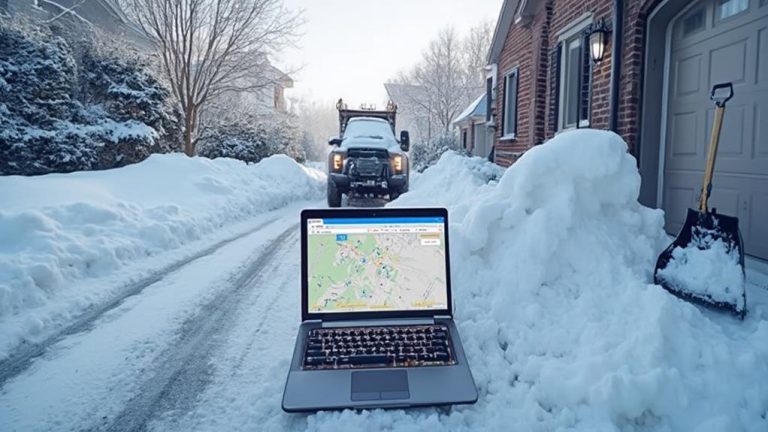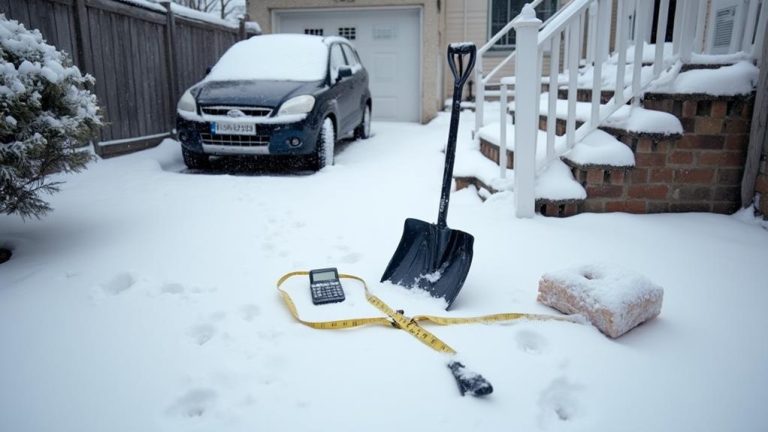Effective sidewalk and walkway snow removal combines several techniques to guarantee pedestrian safety and accessibility. You’ll need to employ a mix of ice-melting methods, including environmentally friendly de-icing agents and professional-grade equipment. Chemical deicers like sodium chloride, calcium chloride, and magnesium chloride are essential for lowering freezing points and tackling stubborn ice. For enhanced traction, consider applying sand or grit, especially in high-traffic areas. Heated walkway systems offer a long-term solution, melting snow automatically. By implementing these strategies, you’ll reduce slip-and-fall accidents, minimize liability risks, and maintain compliance with local regulations. The following sections will provide deeper insights into each approach and their specific applications.
Snow Plowing Highlights
- Use chemical deicers like rock salt or calcium chloride to lower the freezing point of ice and snow.
- Apply sand or grit for improved traction, especially when temperatures are too low for deicers.
- Consider heated walkway systems for automatic snow and ice melting in high-traffic areas.
- Employ environmentally friendly de-icing agents and targeted application techniques to minimize environmental impact.
- Comply with local snow removal regulations and focus on enhancing pedestrian safety and accessibility.
Ice-Melting Techniques for Sidewalks
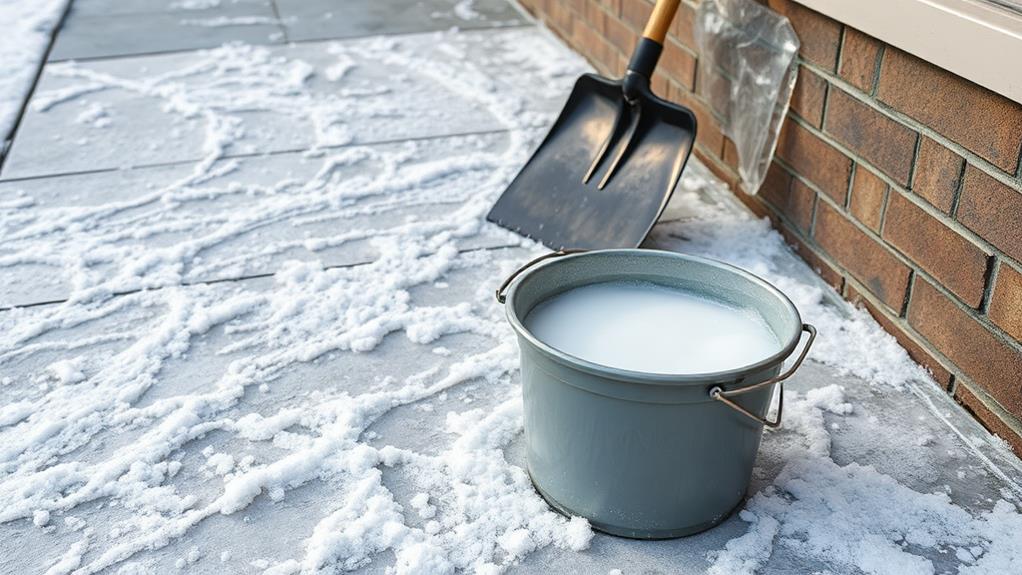
Snow Plow Solutions offers expert ice-melting services for sidewalks, ensuring safe and accessible pathways during winter. Our trained technicians use a combination of environmentally friendly de-icing agents and professional-grade equipment to effectively break down ice and prevent refreezing.
As a company born from experiences with challenging Minnesota winters, we tailor our approach to each property’s specific needs, considering factors like surface material, temperature, and pedestrian traffic. By employing targeted application techniques and regular maintenance, Snow Plow Solutions helps businesses and homeowners minimize slip hazards, reduce liability risks, and maintain compliance with local snow removal regulations.
Our prompt and reliable service keeps sidewalks clear and safe throughout the winter season.
Chemical Deicers and Salts
Chemical deicers and salts are effective tools for melting ice on sidewalks and walkways. When you’re faced with icy conditions, these products can help you maintain safe passages for pedestrians and prevent slip-and-fall accidents. The most common chemical deicer is sodium chloride, or rock salt, which lowers the freezing point of water and breaks the bond between ice and pavement.
However, it’s vital to recognize that rock salt becomes less effective at temperatures below 15°F (-9°C). For colder conditions, you might consider calcium chloride or magnesium chloride, which work at much lower temperatures and are often more environmentally friendly. When applying deicers, it’s paramount to use the appropriate amount, as overuse can damage concrete, vegetation, and water sources. You’ll want to spread the product evenly across the surface, focusing on high-traffic areas and trouble spots.
Remember that deicers work best when applied before ice forms or immediately after snow removal. By incorporating chemical deicers and salts into your snow removal strategy, you’ll be better equipped to handle winter weather and guarantee the safety of those using your sidewalks and walkways.
Sand and Grit Application
When facing icy sidewalks, sand and grit application offers a non-chemical alternative to improve traction and safety. You’ll find that this method is particularly effective when temperatures are too low for chemical deicers to work efficiently. By spreading sand or grit, you’re creating a rough surface that provides better footing for pedestrians and reduces the risk of slips and falls.
To apply sand or grit effectively, you’ll need to use a broadcast spreader or handheld dispenser. It’s essential to distribute the material evenly across the surface, focusing on high-traffic areas and spots prone to ice formation. You’ll want to use angular materials like crushed stone or sand with varying particle sizes for ideal traction. Keep in mind that while sand and grit don’t melt ice, they’ll help prevent it from bonding to the pavement, making subsequent removal easier.
After the snow and ice have melted, you’ll need to sweep up the remaining sand or grit to prevent it from clogging storm drains or damaging landscaping. This method is environmentally friendly and cost-effective, making it a popular choice for those seeking sustainable snow removal solutions.
Heated Walkway Systems
Designed for long-term snow and ice management, heated walkway systems offer a hands-off approach to keeping your sidewalks clear. These advanced systems typically consist of heating elements embedded beneath the walkway surface, which can be activated automatically or manually to melt snow and ice as it accumulates. You’ll find that most heated walkway systems utilize electric heating cables or hydronic tubing filled with a heat-transfer fluid, both of which effectively distribute warmth across the surface area.
When considering a heated walkway system for your property, you’ll need to weigh the initial installation costs against the long-term benefits. While the upfront investment may be substantial, you’ll save considerably on manual snow removal, de-icing chemicals, and potential liability issues related to slip-and-fall accidents. Additionally, these systems can be integrated with smart controllers and sensors, allowing for efficient energy usage by activating only when necessary. You’ll appreciate the convenience of maintaining clear, safe walkways without the need for constant monitoring or manual intervention, especially during heavy snowfall events or prolonged freezing temperatures.
Benefits
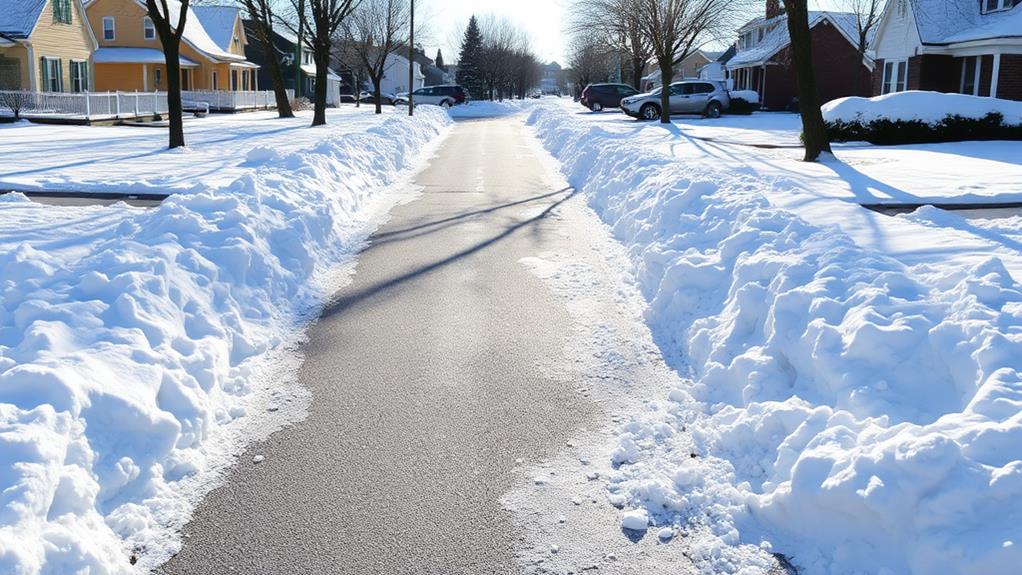
When you prioritize sidewalk and walkway snow removal, you’re investing in a multitude of benefits that extend beyond mere convenience. By ensuring clear, safe pathways, you’re considerably enhancing pedestrian safety, reducing the risk of slip-and-fall accidents, and consequently minimizing potential liability for your property.
With reliable snow clearing for homeowners and efficient ice control, this proactive approach improves accessibility for all individuals, including those with mobility challenges, while simultaneously ensuring compliance with local regulations that often mandate timely snow removal from public walkways.
Enhanced Safety for Pedestrians
Ensuring clear sidewalks and walkways during winter considerably enhances pedestrian safety. When you prioritize snow removal, you’re not just clearing a path; you’re creating a safer environment for your community. By removing snow and ice, you’re reducing the risk of slips, falls, and injuries that can occur when pedestrians navigate treacherous, snow-covered surfaces. This is especially vital for vulnerable populations, such as the elderly or those with mobility issues, who may otherwise be confined to their homes during snowy periods.
Moreover, proper snow removal improves visibility for both pedestrians and drivers, decreasing the likelihood of accidents at intersections and driveways. You’ll also be facilitating easier access to public transportation and essential services, ensuring that your community remains connected and functional even in harsh winter conditions. By maintaining clear walkways, you’re promoting physical activity and encouraging people to continue their daily routines, which is beneficial for both physical and mental health.
Additionally, well-maintained sidewalks and walkways can prevent snow and ice from compacting and forming dangerous, long-lasting patches that pose ongoing risks to pedestrians throughout the winter season.
Reduced Liability for Property
In addition to enhancing safety, proper sidewalk and walkway snow removal can greatly reduce liability risks for property owners. By maintaining clear, ice-free paths, you’re not only protecting pedestrians but also safeguarding yourself from potential lawsuits and insurance claims.
When you prioritize snow removal, you’re demonstrating due diligence and a commitment to safety, which can substantially strengthen your legal position in the event of an accident.
To further minimize liability, consider implementing these essential steps:
- Document your snow removal efforts, including dates, times, and methods used.
- Post visible warning signs in areas that may still pose a risk despite your best efforts.
- Maintain a regular inspection schedule to identify and address new hazards promptly.
Improved Accessibility for All
Proper snow removal from sidewalks and walkways offers significant benefits for accessibility. When you prioritize clearing these pathways, you’re ensuring that everyone in your community can navigate safely and independently. This includes individuals with mobility challenges, such as those using wheelchairs, walkers, or canes, as well as parents with strollers and elderly residents who may have difficulty with balance. By maintaining clear, ice-free surfaces, you’re creating an environment where people of all abilities can participate fully in daily activities without fear of injury or isolation.
Moreover, improved accessibility through effective snow removal contributes to a more inclusive community atmosphere. You’ll notice increased foot traffic in commercial areas, as customers can easily access local businesses. Public transportation becomes more viable when bus stops and train stations are easily reachable. Schools and community centers remain accessible, allowing for continued education and social engagement. By investing in thorough snow removal, you’re not just clearing paths; you’re opening doors to opportunity and connection for all members of your community, regardless of their physical capabilities or age.
Compliance With Local Regulations
Compliance with local snow removal regulations offers more than just legal protection for property owners. By adhering to these guidelines, you’re actively contributing to the safety and well-being of your community.
Local ordinances typically outline specific timeframes and standards for clearing snow and ice from sidewalks and walkways, ensuring that pedestrians can navigate safely. When you comply with these regulations, you’re not only avoiding potential fines but also demonstrating your commitment to being a responsible member of your neighborhood.
Understanding and following local snow removal requirements can provide several benefits:
- Reduced liability risks, as properly maintained walkways decrease the likelihood of slip-and-fall accidents
- Improved relationships with neighbors and local authorities, fostering a sense of community cooperation
- Enhanced property value, as well-maintained exteriors contribute to the overall appeal of your property
Snow Plowing Company Near you
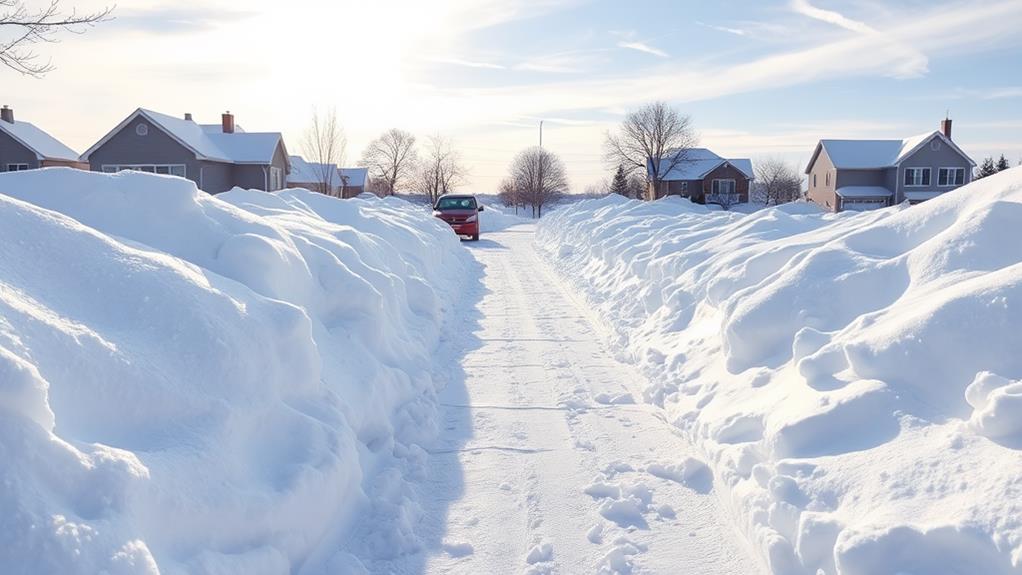
Snow Plow Solutions offers all-encompassing commercial snow plowing and removal services to keep your business accessible and safe during winter weather. Our experienced team utilizes state-of-the-art equipment to efficiently clear parking lots, walkways, and entrances, ensuring minimal disruption to your operations.
We prioritize safety and environmental responsibility by using eco-friendly de-icing products, which aligns with our commitment to sustainability in snow removal services. We provide customized snow management plans tailored to your property’s specific needs, including pre-treatment, snow plowing, and ice control services.
With 24/7 availability and real-time weather monitoring, Snow Plow Solutions is ready to respond quickly to changing conditions, helping you maintain a safe environment for employees and customers while reducing liability risks associated with winter hazards.
Connect With A Team Member Today!
Keep your sidewalks and walkways safe and accessible this winter. Our expert snow removal team is ready to tackle any snowfall, big or small. With our flexible service plans and advanced equipment for efficient snow removal, we provide outstanding service.
Don’t wait until it’s too late – secure your peace of mind today!
Call us at (612) 268-4563 to schedule your snow removal service or get a free quote. Our friendly team members are standing by to answer your questions and tailor a solution to your specific needs.
Take control of winter weather – contact us now!
Winter-Safe Landscaping Tips
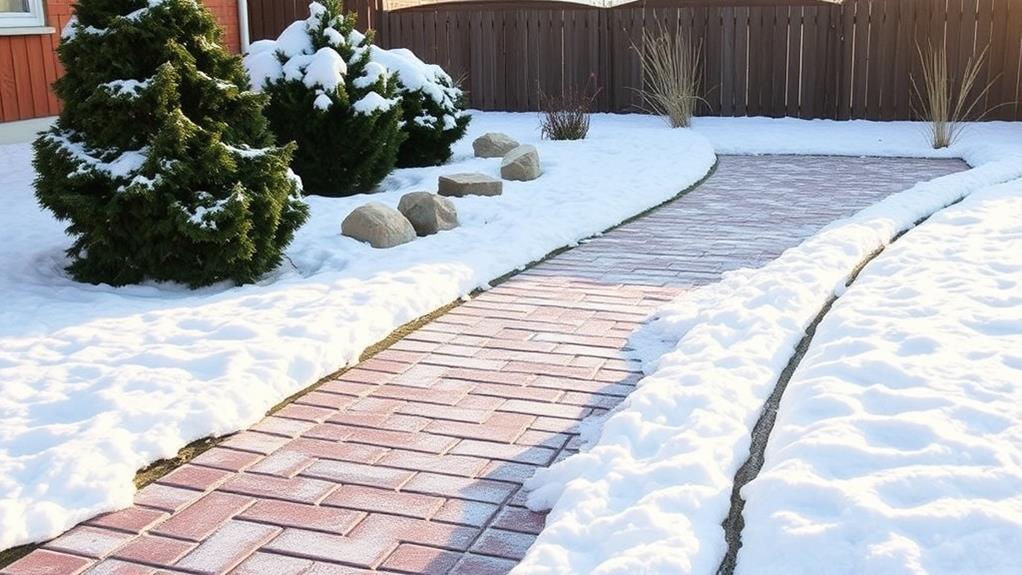
When preparing your landscape for winter, you’ll want to evaluate several key strategies to minimize snow-related damage and maintenance. You can start by selecting snow-resistant plants that can withstand the weight of heavy snow and ice, while also ensuring proper drainage installation to prevent water accumulation and ice formation. Additionally, strategic hardscaping placement can create natural barriers and pathways, reducing snow buildup in critical areas.
| Winter-Safe Landscaping Tips | Benefits |
|---|---|
| Snow-Resistant Plants | Reduced plant damage, less maintenance |
| Proper Drainage Installation | Prevents ice formation, improves safety |
| Strategic Hardscaping | Creates natural snow barriers |
| Winter-Hardy Materials | Increased durability, longevity |
Snow-Resistant Plants Selection
Choosing the right plants for your winter landscape can make a significant difference in how your yard handles snow and ice. When selecting snow-resistant plants, consider species that are native to your region and adapted to cold climates. These plants will be better equipped to withstand the weight of snow and ice accumulation, reducing the risk of damage to your landscape.
To create a winter-hardy garden that complements your snow removal efforts, focus on:
- Evergreen shrubs and trees, such as spruce, pine, and holly, which maintain their foliage year-round and provide structure to your landscape
- Ornamental grasses with sturdy stems that can withstand heavy snow loads, like switchgrass or miscanthus
- Perennials with strong root systems and woody stems, including sedum, coneflower, and black-eyed Susan
Proper Drainage Installation
For proper drainage installation, you’ll need to focus on directing water away from your walkways and foundations. This vital step in winter-safe landscaping involves creating a slight slope that encourages water to flow away from these areas. You’ll want to guarantee that the grade around your home and walkways has a minimum slope of 6 inches over a distance of 10 feet.
To achieve this, you’ll need to assess your current landscape and make necessary adjustments. Start by identifying low spots where water tends to pool, and fill these areas with compacted soil. Next, install French drains or underground pipes to channel water away from your property. These systems work by collecting excess water and redirecting it to a more suitable location, such as a storm drain or dry well. When installing drains, be sure to use perforated pipes surrounded by gravel to facilitate water collection and movement. Additionally, consider incorporating permeable paving materials for your walkways, which allow water to seep through and be absorbed by the ground beneath, rather than accumulating on the surface and potentially freezing.
Strategic Hardscaping Placement
Strategic hardscaping placement can profoundly reduce your winter maintenance workload and enhance safety around your property. By carefully planning the layout of your outdoor spaces, you’ll create an environment that’s both functional and easier to manage during snowy conditions. Consider implementing these winter-safe landscaping techniques:
- Install heated pavers or snow-melting systems beneath walkways
- Use permeable materials for driveways and paths to improve drainage
- Incorporate windbreaks and snow fences to control drifting
When designing your landscape, prioritize accessibility and snow storage areas. Place structures, such as retaining walls or raised planters, strategically to direct snowmelt away from high-traffic areas and prevent ice formation. Additionally, consider the placement of outdoor lighting to illuminate potential hazards during dark winter evenings.
Frequently Asked Questions
How Soon After Snowfall Should I Clear My Sidewalk?
You should clear your sidewalk as soon as possible after snowfall, ideally within 24 hours. It’s not just about following rules; it’s about being a good neighbor and keeping your community safe for everyone. You’re part of the team!
Can I Be Held Liable for Injuries on My Unshoveled Sidewalk?
Yes, you can be held liable for injuries on your unshoveled sidewalk. It’s your responsibility to keep it safe for others. Don’t let your neighbors down or risk legal trouble. Clear that snow promptly to be a good community member!
What’s the Best Type of Shovel for Clearing Snow From Walkways?
You’ll want a sturdy, ergonomic snow shovel with a wide, curved blade. Look for one with a non-stick surface and comfortable handle. It’ll make your job easier and help you bond with neighbors over shared winter chores.
Are There Environmentally Friendly Alternatives to Salt for Melting Ice?
You’ll love these eco-friendly ice melters! Try sand, kitty litter, or coffee grounds for traction. Beet juice, vinegar, or alfalfa meal work well too. You’re part of a community that cares about the environment!
How Can I Prevent Damage to My Concrete Walkway During Snow Removal?
You’ll protect your concrete by using plastic shovels instead of metal ones. Don’t use harsh chemicals; opt for sand or kitty litter for traction. Avoid overusing salt, and clear snow promptly to prevent ice buildup. We’re all in this together!

